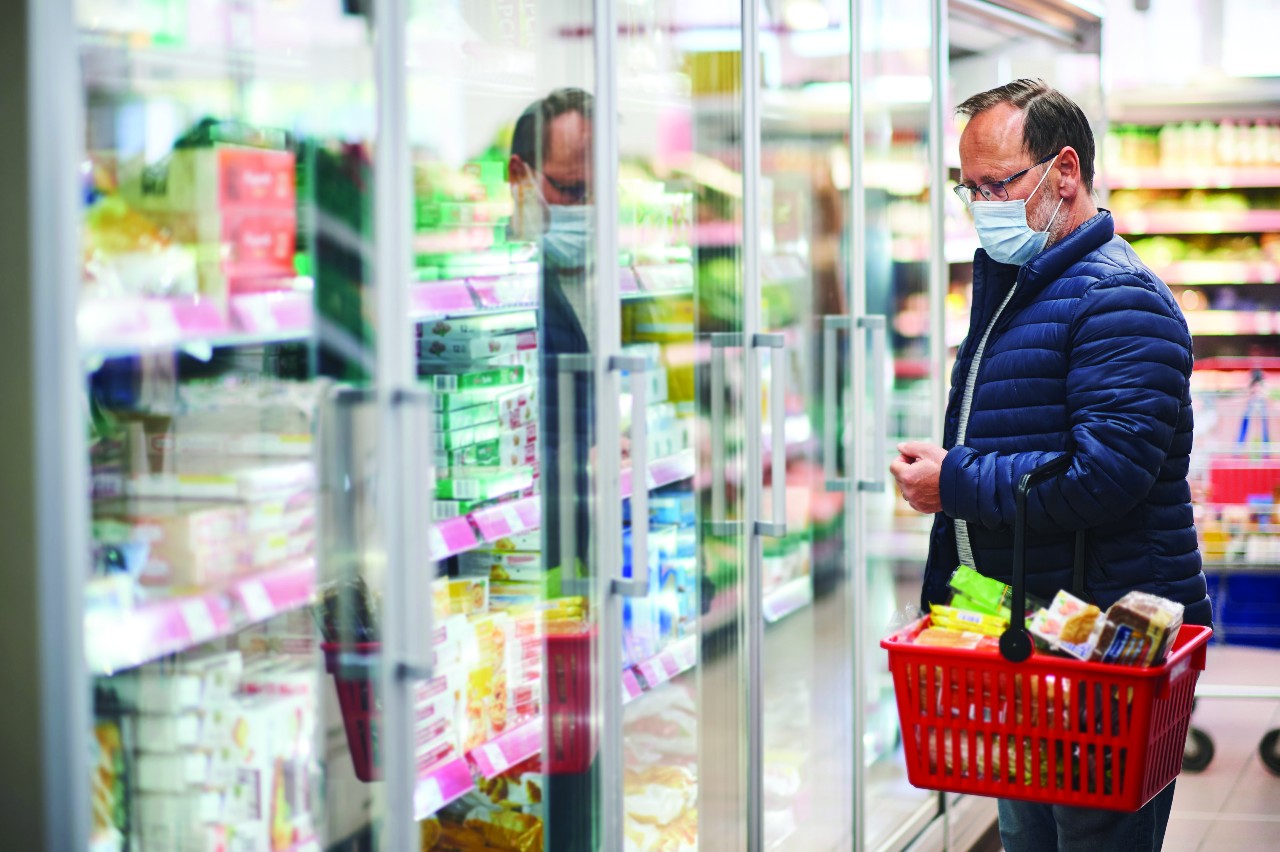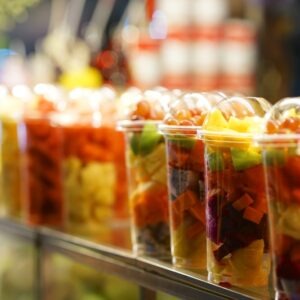Focus on how the Covid-19 pandemic has impacted the global food packaging supply chain, in terms of demand and consumer behaviour, as the industry adjusts to the new normal.

Supermarkets have sought to shorten supply chains and utilise local suppliers to continue to serve customers during the pandemic with minimal disruption. (Credit: Anna Nahabed/Shutterstock.com)
The effects of the coronavirus on the global food packaging supply chain have been wide-ranging and filled with consequences for the industry as a whole. Matthew Rogerson speaks to producers and brands, in addition to using market data from GlobalData, to learn about the impact of the virus in real time in terms of consumer behaviour, demand and companies’ efforts to adjust to the new normal.
Before honing in on the impact of the pandemic on the food packaging supply chain, it is important to understand the market and the forces impacting it. Covid-19 has changed where consumers work from and how they get their food, and raised awareness of social distancing and the need to wear a mask to protect ourselves and others.
In its cross-sector impact report on coronavirus published in July 2020, GlobalData reported that large numbers of employees are now worried about returning to offices, which has knock-on effects.
If there are no workers in offices, the hospitality industry that serves them is unable to stay open. At the same time, large numbers of consumers are now unemployed or continuing to work from home, which requires their goods to get to their home rather than being in physical brick-and-mortar shops.
Overall, the consumer market has seen a massive drop in value of 3.9%, equivalent to $358.2bn in lost revenue. Alcoholic drinks, cosmetics and toiletries are the main categories struggling to stay afloat, while food and household goods are the only ones seeing significant gains in 2020.
To address these issues in demand, the food sector supply chain has had to become incredibly efficient. One of the most popular techniques used by companies to safeguard their supply chains was the use of rationalisation. This involves simplifying product SKUs, running fewer down the line and focusing on a few size formats.
It is important to realise that, in the supply chain, like manufacturing in general, every additional step increases the time and cost. Each time food is wrapped, filled, packed and labelled, there is a bottleneck and a reduction in speed and efficiency.
By simplifying manufacturing to three or four product sizes, more goods can be made and sold directly to consumers. Any product lines that have low demand can be stopped to make way for higher-demand goods.
This way the supply can keep up with changes in demand, even when there are major spikes. As there have been no critical supply chain failures reported, this strategy seems to be working.
Food suppliers adjust to alternative demands
While the effects of the pandemic have been felt across the food industry, it has had a particularly devastating impact on the foodservice market. With restaurants forced to close, a number of suppliers and supply chains have had to divert their activities away from food service to alternatives in order to stay in business. At the same time, food waste is a very real issue that has been exacerbated by multiple factors over the lockdown period.
The impact has been momentous for some of the largest operators in the food service sector, including McDonald’s, Burger King, Popeyes, Tim Hortons, Pizza Hut and KFC.
Restaurant Brands International (which owns Burger King, Popeyes and Tim Hortons) expects to lose $6.3bn across its restaurants in 2020, while Yum Brands (which operates Pizza Hut, KFC and Taco Bell) predicts losses of $9.7bn across its businesses and McDonald’s is forecast to lose a staggering $16.7bn.
This is no surprise, considering the foodservice industry was almost completely shut down during lockdown. As such, its entire supply chain has had to adapt or adjust in order to support other sections that have seen an increase in demand.
Some foodservice suppliers have redirected their products directly to consumers, while big producers such as Tyson Foods and JBS have moved some of their foodservice products into the retail market in order to satisfy demand.
Lifeline to local food suppliers
If the biggest losses were in food service, retail has seen the largest swing in fortunes, requiring the most agile supply chain to cope with explosive demand. One key development in the retail sector has been increased efforts to secure and promote local suppliers.
By buying locally, retailers can speed up time to market, have a shorter logistics chain and reduce the number of stages in which something might happen to affect or disrupt the supply.
Supply chains appear, much like manufacturing plants, to operate better in simplicity – the more parts going in or out of the chain, the more countries it goes through and distance it covers, the more potential for something to go wrong, be delayed or not function to maximum efficiency.
Enough of these small delays put together could cause major disruption at the other end. Retailers looking to address overwhelming demand are inevitably going to take the path of least resistance.
Local support and supply is a common theme within both the retail and food sectors. Supermarket chain Waitrose launched a special ‘best of British’ cheese selection box to support its smaller UK-based artisan cheese suppliers adversely affected by the pandemic.
The box is filled with five of Waitrose’s most popular UK artisan cheeses and is designed to help small-scale producers who normally rely on cheese service counters for business.
As part of the company’s press release, Alice Shrubsall, assistant cheese buyer at Waitrose, said, “Covid-19 created a big shift in the way people shop, particularly in the early stages, with more people wanting to grab and go.
We recognised this trend and quickly adapted our approach to ensure our smallest cheese counter suppliers had the opportunity to sell their products in packaged form so that they didn’t lose out to the fast shopping habits adopted by customers in recent times.”
French suppliers in fisheries and agriculture have also faced massive downturns as a result of the crisis. Retail giant Carrefour has stepped in to support them by guaranteeing volume and purchase prices for ten major fish species, including mackerel, sardines, ling and whiting.
Around 50% of the fisheries sector’s output is usually directed towards catering businesses, and their closure has had a significant impact, so this provides a valuable lifeline for local suppliers.
Meanwhile, the shutdown of restaurants and open-air food markets has weighed on smaller local fruit and vegetable producers. Carrefour has also agreed to source its seasonal supplies for its hypermarkets from French growers only. Strawberries, asparagus, cucumbers and tomatoes will all be sourced in France until supplies are exhausted.

Back in the UK, Marks & Spencer has taken a range of measures to ensure that the supply chain continues during this time and have been supporting local farmers to prevent it from going under.
“Despite the enormous challenges they are facing, our family of 10,000 British farmers are supporting us to deliver fantastic quality, fresh food for our customers, so we want to do our bit to support them,” said Stuart Machin, managing director of M&S Food, in a company press release.
“That is why we are standing by our long-standing British sourcing commitments, introducing new initiatives to tackle the problems our agricultural sector faces and reminding customers of the incredible food our nation’s farmers produce.”
Tesco’s CEO Dave Lewis has been somewhat prescient, as the supermarket had been preparing for a ‘doomsday’ scenario over the past four years – though coronavirus was not on their radar, supply systems and remote working tools have been upgraded and honed so that, at the time of writing, fewer than 30 people have been working at the supermarket chain’s vast campus in Hertfordshire, which usually houses about 6,500 workers.
Tesco also survived the panic-buying phase, with Lewis noting, “Our biggest day of the year is normally 23 December. “We know when that is and have all year to plan for it” says Lewis.
“With no notice, we had five days at that level and no chance to plan. In certain categories we were selling seven weeks worth of sales in five or six days. That pace in demand is unbelievable. The whole industry emptied the front end of the supply chain and then we had to recover.”
What can be seen across all retailers, from Tesco to Amazon, is that rationalisation of the goods being produced – combined with shortened supply chains and the rise in local supply – has meant that even at peak demand, which varies 30–48% higher than their biggest sales days in a given year, the supply chain has been able to serve producers and consumers alike with minimal disruption.
Impact on the food packaging supply chain
The meat industry, especially in the US, is highly concentrated, with a few providers and major plants responsible for vast amounts of the world’s food supply.
With people closely working alongside each other in tight airless spaces, the virus was able to go through meat processing plants extremely quickly, causing major locations to close down and disrupting 10–15% of the supply chain.
However, the industry has adapted working practices to prevent further disruption. In a company press release, JBS USA CEO Andre Nogueira said: “We recognise our responsibility as a food company during this crisis and we have continuously evolved our operations, based on the latest available guidance from experts, to improve our coronavirus preventive measures.”
New technologies are being implemented, such as UV germicidal air sanitation and plasma air technology to neutralise potential viruses in plant ventilation and air purification systems.
JBS’s Greeley beef facility had a major outbreak of the virus and was voluntarily shut down, even though it produces roughly 10% of beef on the US domestic market.
Social distancing and protection of front-line employees are crucial to halting the spread of the disease and allowing factories to remain open so that the food packaging supply chain is not disrupted.
These new adaptations, which include deep cleaning factories, reducing the human workforce and keeping them 2m apart at all times, all lead to a spike in the cost of maintaining the supply chain, but they are undoubtedly worth it to ensure supply remains.
Dean Banks, president of Tyson Foods, makes it clear that there is plenty of food available – even with the panic buying and rapid demand that we have seen around the world.
He said: “The focus is on continuing to keep the food supply running. We’re shifting some of our chicken, beef and pork production from the foodservice segment to meet the surge in demand for retail food products. The food supply in the US is more than sufficient.”
Problems that have occurred arise from consumers’ panic buying, outstripping supply, while the measures to ensure that factories are clean and observing social distancing mean that extra costs are being added to the manufacturing cycle and food packaging supply chain.
Some of the immediate noticeable changes Banks points out include measures to provide flexibility to meet increased demand, and efforts to work closely with retail partners to ensure products make it to the shelves. “With more than 100 food production plants in the US, our unique scale allows us to quickly adjust, and meet the current demand at grocery and other retail stores,” he says.
“We’re working with our customers to fill and ship orders as rapidly as possible. In some cases, our capability to shift processes in individual plants is allowing us to quickly pivot to producing retail items.
“For example, changing packaging from a foodservice product to a retail product can occur quickly because of the built-in flexibility of our operations.”
This article first appeared in Packaging & Converting Intelligence
